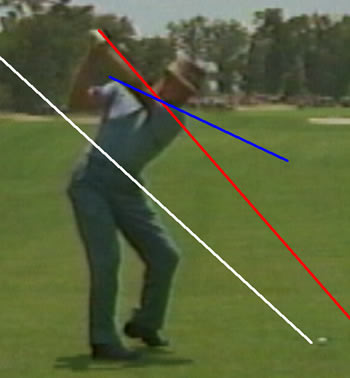
7-16 (Knee Action)
Knee Action is classified based on the combinations of bent and straight knee conditions. Knee bend and knee straightening determines hip slant which is the 'slant' angle between the right and left hip.
If you straighten the right knee at the top of the swing, you will have more hip slant than if you have the right knee more flexed. Sam Snead straightened the right knee out (straightened, not LOCKED) and had more hip slant than a golfer who would keep the right knee flexed.

The hip slant effects the hip turn. More hip slant = more backswing hip turn. Less Hip Slant = less backswing hip turn.
Actually, the primary function of Knee Action -- as with Waist Bend -- is to maintain a motionless Head during the Stroke.Less knee bend will restrict the Pivot and Hip Slide and the more upright the plane tends to be. So if you're looking to flatten out your swing, more knee bend may be the answer. The S&T guys teach a straightened (not locked) right knee at the top of the swing. This allows more of an upright shoulder turn. To combat that, the S&T guys teach to take the hands much more inside than most other swings.
If the knee actually locks on the backswing, it will HAVE TO unlock on the downswing and Homer states that subsequent unlocking is disruptive.
Homer then talks about 'anchor' designs where the right and/or the left knees can be bent so it acts as an anchor throughout the entire stroke. We'll go over these knee anchors later on.
7-17 (Foot Action)
I think 7-17 is so important and so overlooked that I want to post the entire 3 paragraph section.
Foot Action accomodated the Knee Action resulting from the motion of the Weight Shift, and accepts the changes in the loading of the Feet. The loading can shift between the inner and the outer edge of the Foot but shouldn't roll the Foot over on its edge. The majority of the weight should be on the heel and its better to turn on one's heel than to roll excessively. Address Position loading of the Feet is even distribution between both Feet but with enough on the heels to allow the toes to be lifted up momentarily without altering the distribution between the toe and heel.The feet accomodates the knees which helps accomodate the PIVOT. The weight should move anywhere from the inner edge of the foot to the outer edge, but should not roll over on the outer edge. Furthermore, you should be able to lift the toes upward momentarily. Keep the weight off the toes if you can because it can cause some serious flaws in the Geometry of your swing. If anything, I try to keep the weight in the middle of the arches of the feet, sort of like feeling as though the arches in your feet are 'suction cups' to the ground.
The heel should not be lifted off the ground, but pulled off -- and then no more than necessary. Merely lifting the heel accomplishes nothing.
Halting the Backstroke motion with the Feet and letting this same tension pull the Downstroke through Impact is 'swinging from the Feet' and gives the Stroke Maximum Swing Radius.
Homer talks about 'swinging from the feet' which is very similar to what Sevam1 has discussed in his e-book 'The Secret Is In The Dirt.' Homer basically states that this is a good thing because it maximizes the swing radius (more extension in the swing) which helps create more power.
Here's a couple of videos I did on 7-17.
3JACK
3 comments:
Rich, correction suggestion: in the second last para., line 3, about rolling to the outside of the foot ... I think you meant to say "should not" rather than "should"
Dan.
Yes, I think too, that's what he ment.
Thanks for the correction, guys.
Post a Comment